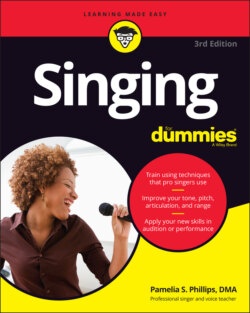Читать книгу Singing For Dummies - Pamelia S. Phillips - Страница 54
BREATHING LIKE A BELLOWS
ОглавлениеAttached to your ribs, your lungs are made of pliable tissue — not muscle. When you inhale, the muscles between the ribs (intercostals) move the ribs up and out as the lungs expand downward. When the intercostal muscles relax back inward, the lungs move back to their normal resting position. Another muscle that moves when you breathe is your diaphragm, a dome-shaped muscle located underneath your lungs and attached to the ribs and the spine. Your diaphragm is actually attached to the rib cage in the front of your body and the ribs and spine in the back, and it doesn’t descend below your ribs. When you inhale, the diaphragm flexes downward and moves back upward as you exhale. If the diaphragm flexes downward as you inhale, the organs below your diaphragm (such as the liver and your stomach) have to move out of the way. The organs move down and out, which is why your abdomen moves out as you inhale. As you exhale, the organs gradually move back to their normal resting positions.
Breathing can be confusing for a singer who’s just starting out, because you have to pay attention to so many things at one time. Different people who know something about singing also may tell you about yet another breathing method to use for singing. One friend may say that their teacher wants them to leave the muscles out — sides, ribs, back — and distended as they sing or exhale; another friend may tell you that the abdominal muscles must move in when you exhale. Who do you believe? Both of them.
More than one method of breathing is useful, so you need to explore what works for you and understand why. You’ll likely encounter someone who claims to know all the answers about breathing, and I want you to be familiar with your own breathing to understand your options.
Being an “innie” or an “outie” doesn’t refer to just your belly button — it also refers to how you breathe. Both methods are valid; you just need to understand how breath works in your body. Here’s more info about each:
The innie method focuses on moving the ribs and abdomen in gradually during exhalation. If you’re exploring breathing for the first time, start with these exercises.
The outie method requires the singer to focus on keeping the ribs or abdomen out during exhalation. For many singers, the outie method is helpful because beginners have a hard time preventing the ribs and abdomen from moving back in too quickly during exhalation; visualizing the abdomen staying out helps them slowly move back in. After their abdomen moves back in, some singers squeeze their throat to continue singing. You can explore the outie method to see whether imagining your body staying wide during exhalation helps you slow the movement of your ribs and abdominal muscles and extend your breath.
